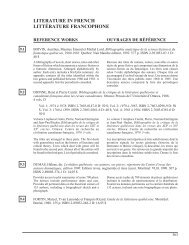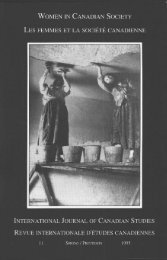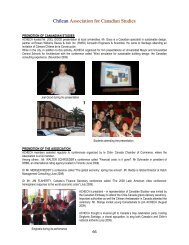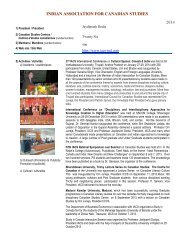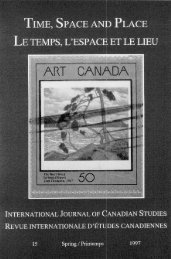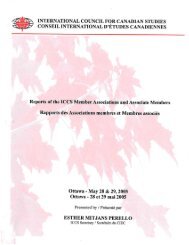Arts and Literature in Canada:Views from Abroad, Les arts et la ...
Arts and Literature in Canada:Views from Abroad, Les arts et la ...
Arts and Literature in Canada:Views from Abroad, Les arts et la ...
- No tags were found...
You also want an ePaper? Increase the reach of your titles
YUMPU automatically turns print PDFs into web optimized ePapers that Google loves.
IJCS/RIÉCl<strong>and</strong>scape as <strong>in</strong> Ross' “The Walk”: there is no pronoun <strong>in</strong> the whole poem thatwould personalize its focaliz<strong>in</strong>g agent <strong>and</strong> thus evoke the impression of thepersona's physicality. The focalizer of this poem is a m<strong>in</strong>d only, <strong>and</strong> his eye am<strong>in</strong>d-eye liberated <strong>from</strong> the logic of physical movement. This freedom ofsee<strong>in</strong>g, with its float<strong>in</strong>g viewpo<strong>in</strong>t, has a dream-like quality which correspondsto the l<strong>and</strong>scape's <strong>la</strong>ck of topographical concr<strong>et</strong>eness: the prom<strong>in</strong>ent use ofplurals (suns<strong>et</strong>s, moons, crests, surfs ...) deprives the l<strong>and</strong>scape of specificity<strong>and</strong> enhances the impression that the poem presents a vision rather than afaithful description of l<strong>and</strong>scape. Expressions like “shadowy, ghost-likeshores” <strong>and</strong> “l<strong>and</strong>s that loom like spectres” are even clearer <strong>in</strong>dicators that thew<strong>in</strong>ter <strong>la</strong>kes <strong>in</strong> Campbell's poem are a m<strong>in</strong>dscape not “pa<strong>in</strong>ted” <strong>from</strong> nature. Afixed perspective would mar this effect by provid<strong>in</strong>g an <strong>in</strong>appropriate sense ofvisual concr<strong>et</strong>eness.A “destruction of the perspective scheme” (C<strong>la</strong>udio Guillén 1971: 360f.)becomes a major aesth<strong>et</strong>ic effect <strong>in</strong> the modern period, <strong>in</strong> pa<strong>in</strong>t<strong>in</strong>g as well asliterature. Accord<strong>in</strong>g to Marshall McLuhan, modern art “reverses thedevelopment of perspective”:Whereas <strong>in</strong> the Renaissance it was the encounter with the newpictorial or visual space that created discomfort <strong>and</strong> dismay, thereverse is true <strong>in</strong> our time. It is the rediscovery of nonvisual,multisensuous spaces that bothers <strong>and</strong> confuses us. (McLuhan/Parker 1968: §28)Verbal art is b<strong>et</strong>ter suited than visual art to capture this “nonvisual,multisensuous” experience <strong>and</strong> also to thematize the breakdown of establishedperceptual modes. In Canadian l<strong>and</strong>scape po<strong>et</strong>ry, the modern trend towardsaperspectivism 15 also has a national fac<strong>et</strong> — the experience of liv<strong>in</strong>g <strong>in</strong> acountry that seems too vast <strong>and</strong> empty to be grasped <strong>in</strong> either visual orconceptual terms.McLuhan <strong>in</strong> the quotation above contrasts modern aperspectivism with aspecific notion of perspective <strong>in</strong> the history of Western art: that of theRenaissance. It is perspective <strong>in</strong> this sense which also underlies many modernCanadian l<strong>and</strong>scape poems.This is particu<strong>la</strong>rly obvious <strong>in</strong> Margar<strong>et</strong> Avison's “Perspective” (1940), wherea double reference to Andrea Mantegna makes it clear to which k<strong>in</strong>d ofperspective the poem's title alludes. Italian pa<strong>in</strong>ters of the 15th century“<strong>in</strong>vented” a perspective scheme constructed on the grounds of projectivegeom<strong>et</strong>ry. 16 The picture p<strong>la</strong>ne is envisaged as an <strong>in</strong>tersection of the visualpyramid whose po<strong>in</strong>t is constituted by the human eye; l<strong>in</strong>es that go <strong>in</strong>to thepicture's depth converge on a s<strong>in</strong>gle vanish<strong>in</strong>g po<strong>in</strong>t. Accord<strong>in</strong>g to thisscheme, space is fully comprehensible <strong>and</strong> constructible by the human m<strong>in</strong>d.In a very literal sense, the human subject becomes the measure of the objectiveworld.18



